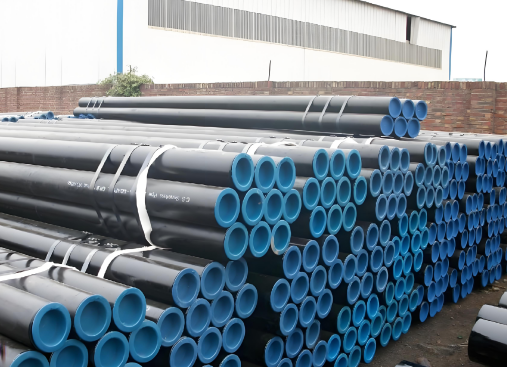What is API 5L line pipe?
API 5L line pipe is a pipeline system specially used for long-distance transportation of fluid media such as oil, natural gas, and water. Its main function is to safely and efficiently transport these resources from the mining site to the processing or use site.
API 5L line pipe covers two categories: seamless pipe and welded steel pipe. The core characteristics of line pipe are high sealing and pressure resistance, which can adapt to high pressure, corrosive media and complex environmental requirements to ensure safety and reliability during transportation. At present, welded pipes dominate the large-diameter field with their molding technology advantages, but seamless pipes still maintain their application value in specific working conditions.

Main uses:
Long-distance oil and gas pipelines, urban gas pipelines and other scenarios.
Fluid transportation of offshore platforms, refineries and chemical facilities.
Some engineering infrastructure (such as high-voltage transmission towers, drainage pipes).
What is API 5L seamless line pipe?
API 5L
Seamless line pipe is a weldless steel pipe specially used in the field of fluid transportation such as oil and natural gas, which meets the API 5L standard formulated by the American Petroleum Institute (API). Seamless line pipe is produced by hot rolling or cold drawing process, has no longitudinal welds, continuous overall structure, and better pressure bearing capacity than
welded pipe.
API 5L Seamless line pipe steel mainly includes: GR.B, X42, X46, X52, X56, X60, X65, X70. The main difference between these steel grades is their minimum yield strength. As the steel grade number increases, the strength of the steel also increases.
Core advantages:
No weld weakness: strong integrity, avoiding the risk of weld defects that may exist in welded pipelines.
Strong pressure bearing capacity: suitable for high-pressure transportation (such as submarine pipelines, high-pressure gathering and transportation pipelines).
Corrosion resistance: By adding elements such as Cr and Mo, the H₂S corrosion resistance can be improved (such as sulfur-resistant pipelines).
The inner wall is smooth, the fluid resistance is small, and it is suitable for high-purity medium transportation (such as liquefied natural gas).
Standards and Grades:
API 5L pipeline product quality grades are divided into PSL1 (basic grade) and PSL2 (high performance grade), the latter of which has stricter requirements in chemical composition, testing, etc.
PSL1: basic requirements, suitable for general working conditions, steel grade range is A25~X70.
PSL2: higher requirements, mandatory requirements for carbon equivalent, impact toughness, etc., steel grade range is B~X80.
Steel grade classification:
A25, A, B: early standard steel grades, with low yield strength (for example, B grade ≥241MPa), suitable for general use.
B, X series (X42~X100): The number represents the minimum yield strength (unit: ksi), for example, the minimum yield strength of X42 steel is 420MPa, and the minimum yield strength of X120 steel is 1000MPa.
Application scenarios of different grades:
Grade A and B: suitable for general industrial pipelines and low-pressure applications.
X42 to X70: suitable for oil and gas pipelines under high pressure and high temperature environments.
X80 and above: suitable for long-distance oil and gas pipelines under extreme conditions, especially pipelines requiring high strength and high corrosion resistance.
Special steel grade for corrosion resistance:
L245N/L290N: low carbon equivalent, resistant to hydrogen sulfide (H₂S) stress corrosion, suitable for acidic oil and gas fields.
L360N/L415N: added Cr and Mo, resistant to CO₂ and Cl⁻ corrosion, suitable for offshore platforms and chemical media transportation.
Seamless line pipe production process:
Hot rolling method (suitable for large-diameter thick-walled pipes):
Round billet heating → perforation → rolling → sizing → cooling (such as Φ219~660mm).
Cold drawing method (high-precision thin-walled tube):
Hot-rolled billet → pickling → cold deformation → annealing (such as Φ10~150mm, wall thickness 1~20mm).
Comparison with welded line pipe:
Comparison items
|
API 5L seamless pipe
|
API 5L welded pipe (such as ERW, LSAW)
|
Pressure bearing capacity
|
Higher (no weld weak point)
|
Weld zone strength is 10%~20% lower
|
Applicable diameter
|
Usually ≤24 inches (Φ610mm)
|
Up to 56 inches (Φ1422mm)
|
Cost
|
High (complex process)
|
Low (suitable for mass production)
|
Typical scenarios
|
Ultra-high pressure, corrosive media
|
Long-distance land pipelines
|
Anti-corrosion and coating options:
Internal anti-corrosion: epoxy resin coating (used for water transmission and rust prevention).
External anti-corrosion:
3PE (three-layer polyethylene): buried pipeline corrosion resistance.
FBE (fusion-bonded epoxy powder): high temperature resistance (≤110℃).
Special needs: duplex stainless steel lining (chloride ion corrosion resistance).
Key points for steel grade selection:
1. Pressure level
Low pressure (≤6MPa): A25, B grade.
Medium and high pressure (6~12MPa): X52~X70.
Ultra-high pressure (>12MPa): X80 and above.
2. Environmental requirements
Low temperature environment: select X65/X70 (-40℃ impact energy meets the standard).
Acidic medium: select L245N/L360N (resistant to H₂S corrosion).
3. Cost trade-off
The price of X series steel grade is 30%~50% higher than that of B grade, and it needs to be selected according to demand.
Conclusion:
API 5L seamless line pipe has become the first choice for harsh working conditions (high pressure, corrosion, low temperature) due to its no welds, high pressure bearing capacity and high reliability. When selecting, it is necessary to comprehensively consider the steel grade, PSL level and anti-corrosion requirements, and give priority to PSL2 products for key projects. For larger diameter (>24") requirements, LSAW welded pipes may be considered as an economical alternative.
Read more: API 5L PSL1/PSL2 Pipe Specification or ASTM Standards for Steel Pipes


